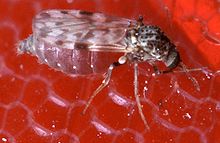- Culicoides
-
Culicoides 
Culicoides sonorensis after blood meal Scientific classification Kingdom: Animalia Phylum: Arthropoda Class: Insecta Order: Diptera Family: Ceratopogonidae Subfamily: Ceratopogoninae Tribe: Culicoidini Genus: Culicoides
Latreille, 1809Subgenera Numerous, see text
Culicoides is a genus of biting midges in the subfamily Ceratopogonidae. Around 500 species of Ceratopogonidae are at present placed in the genus and this is split into many subgenera. Several species are known to be vectors of various diseases and parasites which can affect animals.
Contents
Notable taxa
The systematics and taxonomy of this genus are confused. A large number of species are of unknown relations to those that have been assigned to subgenera already. Furthermore, many subgenera are sometimes elevated to full genus status, or additional genera (such as Paradasyhelea) are included as subgenera herein.
- Subgenus Avaritia
- Culicoides brevitarsis - suspected as vector of Akabane and Aino virus
- Culicoides imicola - main vector of bluetongue virus and African Horse Sickness in Southern Europe
- Culicoides chiopterus -
- Culicoides dewulfi -
- Culicoides obsoletus -
- Culicoides scoticus -
- Subgenus Beltranmyia
- Culicoides circumscriptus
- Culicoides manchuriensis
- Culicoides salinarius
- Subgenus Culicoides
- Culicoides nipponensis
- Culicoides punctata
- Subgenus Drymodesmyia
- Culicoides loughnani
- Subgenus Haematomyidium
- Culicoides insinuatus
- Culicoides paraensis - vector of Oropouche virus
- Subgenus Haemophoructus
- Culicoides gemellus
- Subgenus Hoffmania
- Culicoides foxi
- Culicoides fusipalpis
- Culicoides ignacioi
- Culicoides insignis
- Culicoides lutzi
- Culicoides maruim
- Culicoides paramaruim
- Subgenus Macfiella
- Culicoides phlebotomus
- Subgenus Meijerehelea
- Culicoides guttifer
- Subgenus Monoculicoides
- Culicoides deltus
- Culicoides fagineus
- Culicoides grisescens
- Culicoides impunctatus (Highland midge) - vector for Haemoproteus spp.
- Culicoides newsteadi
- Culicoides nubeculosus
- Culicoides pulicaris
- Culicoides punctatus
- Subgenus Oecacta
- Culicoides furens transmits Mansonella Ozzardi
- Subgenus Remmia
- Culicoides oxystoma
- Subgenus Tokunagahelea
- Culicoides pygmaeus
- Subgenus Trithecoides
- Culicoides anophelis
Species incertae sedis include:
- limai group
- Culicoides limai
- fluviatilis group
- Culicoides fluviatilis
- Culicoides leopodoi
- reticulatus group
- Culicoides guyanensis
- Culicoides paucienfuscatus
- Culicoides reticulatus
Taxonomy
Adults are small dark insects about 1–3 mm long. The antennae are long (15 segments) densely haired in the males and less hairy in females. The Thorax is hooped and carries a pair of broad mottled wings. Only the first two longitudinal veins are distinct.
Biological habits: Both males and females feed on nectar, however only the females feed on blood, which is needed for the maturation of fertilized eggs.[1] Females typically bite at dusk or dawn often in dense swarms and usually in the vicinity of water, marshes or rotting vegetation.
Life cycle of Culicoides: Females lay their eggs en masse in a range of habitats ranging from water vegetation, slow running streams, damp soil or manure heaps. These hatch into tiny smooth white larvae with four pairs of anal gills. Pupae consist of a fused cephalothorax with slender respiratory trumpets and a segmented abdomen. Adults emerge through a straight slit after 3–7 days.
The bite of Culicoides is felt as a sharp prick and is often followed by irritating lumps that may disappear in a few hours or last for days.
Culicoides as a vector
Different Culicoides species have been shown to be vectors for the following viruses and conditions: Mansonella spp. (M. ozzardi, M. perstans, M. streptocerca), Onchocerca gibsoni and O. cervicalis, Leucocytozoon, Plasmodium agamae, bluetongue virus, African horse sickness, bovine ephemeral fever (C. osystoma and C. nipponesis), Akabane virus, Queensland itch and Epizootic Hemorrhagic Disease.
Bluetongue vectors in Northern europe
in 2006, bluetongue virus was first recorded in Northern Europe. In 2007 and 2008, there was a huge outbreaks, going as far as to Norway, and in 2009 the outbreak was smaller. The main vector of the bluetongue virus outbreak in Southern europe does not live in northern europe, and so other species have been screened. Species belonging to the Culicoides obsoletus complex and the Culicoides pulicaris complex have been found capable of bluetongue transmission.
Categories:- Ceratopogonidae
- Veterinary entomology
- Subgenus Avaritia
Wikimedia Foundation. 2010.
